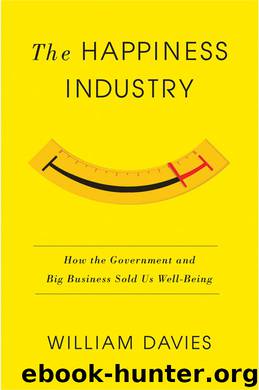The Happiness Industry: How the Government and Big Business Sold Us Well-Being by William Davies

Author:William Davies [Davies, William]
Language: eng
Format: mobi
Publisher: Verso
Published: 2015-05-01T04:00:00+00:00
The science of deflation
The ability of individuals to ‘strive’ and ‘grow’ came under a somewhat different scientific spotlight between 1957 and 1958, due to accidental and coincidental discoveries made by two psychiatrists, Ronald Kuhn and Nathan Kline, working in the United States and Switzerland respectively. As with so many major scientific breakthroughs, it is impossible to specify who exactly got there first, for the simple reason that neither quite understood where exactly they had got to. The era of psychopharmacology was still very young, with the discovery of the first drug effective against schizophrenia in 1952 and the running of the first successful ‘randomized control trials’ (whereby a drug is tested alongside a placebo, with the recipients not knowing which one they’ve received) on Valium in 1954. These breakthroughs opened up a new neurochemical terrain for psychiatrists to explore.
Unlike the developers of those anti-anxiety and anti-schizophrenia drugs, Kline and Kuhn were not sure precisely what disorder they were seeking to target. Kline began experimenting with a drug called iproniazid, which had first been used against tuberculosis, while Kuhn was trialling imipramine in the hope that it might target psychosis. Had they both been certain of what effect they were looking for in advance, it’s doubtful that they would have made any discovery at all. It was because they were not sure that they engaged in extremely careful observation of the drugs’ recipients. Thanks to this, both psychiatrists noticed something that was both banal and revolutionary at the same time.
The drugs did not appear to have any particular effects that could be scientifically classified. There was no specific psychiatric symptom or disorder that they seemed to relieve. Given that psychiatrists of the 1950s still viewed their jobs principally in terms of healing those in asylums and hospitals, it wasn’t clear that these drugs offered anything especially useful at all. As a result, drug companies initially showed little interest in the breakthrough. The drugs simply seemed to make people feel more truly themselves, restoring their optimism about life in general.
People felt better as a result of these pharmaceuticals, not in any specifically medical or psychiatric sense, but more in terms of their capacity for fulfilment and hope. As Kuhn observed, his new substance appeared to have ‘antidepressant properties’. The extraordinary implication, which has since become our society’s common sense, was that sadness and deflation, and hence their opposites, could be viewed in neurochemical terms.
For a while, psychiatrists struggled to know how to describe the new drugs. Kline chose to refer to his as a ‘psychic energizer’, which remains a decent description of many of the drugs currently marketed as ‘antidepressants’, but which are used to treat anything from eating disorders to premature ejaculation. The subtlety of their effects was perplexing, but this very property – this selectivity – has since come to be the main promise of those who seek to transform and improve us via our neurochemistry. Unlike barbiturates, the new drugs did not alter physical metabolism or overall levels of psychic activity.
Download
This site does not store any files on its server. We only index and link to content provided by other sites. Please contact the content providers to delete copyright contents if any and email us, we'll remove relevant links or contents immediately.
| Anthropology | Archaeology |
| Philosophy | Politics & Government |
| Social Sciences | Sociology |
| Women's Studies |
The Secret History by Donna Tartt(18736)
The Social Justice Warrior Handbook by Lisa De Pasquale(12077)
Thirteen Reasons Why by Jay Asher(8734)
This Is How You Lose Her by Junot Diaz(6697)
Weapons of Math Destruction by Cathy O'Neil(6084)
Zero to One by Peter Thiel(5634)
Beartown by Fredrik Backman(5543)
The Myth of the Strong Leader by Archie Brown(5371)
The Fire Next Time by James Baldwin(5196)
How Democracies Die by Steven Levitsky & Daniel Ziblatt(5094)
Promise Me, Dad by Joe Biden(5036)
Stone's Rules by Roger Stone(4989)
100 Deadly Skills by Clint Emerson(4797)
A Higher Loyalty: Truth, Lies, and Leadership by James Comey(4783)
Rise and Kill First by Ronen Bergman(4651)
Secrecy World by Jake Bernstein(4593)
The David Icke Guide to the Global Conspiracy (and how to end it) by David Icke(4552)
The Farm by Tom Rob Smith(4404)
The Doomsday Machine by Daniel Ellsberg(4374)
